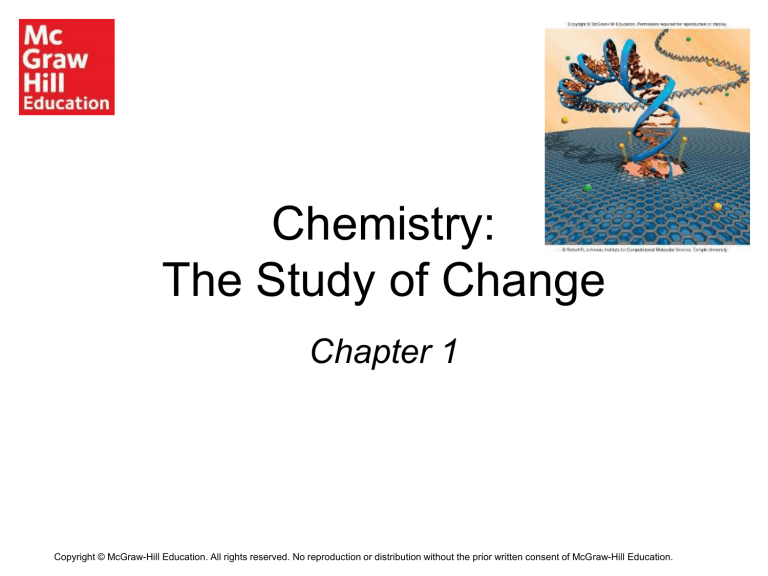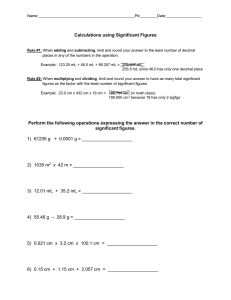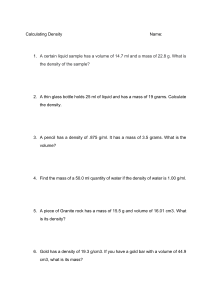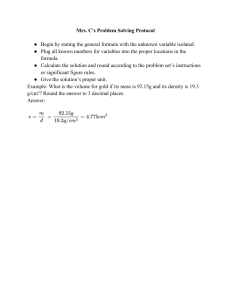
Chemistry: The Study of Change Chapter 1 Copyright © McGraw-Hill Education. All rights reserved. No reproduction or distribution without the prior written consent of McGraw-Hill Education. Chemistry: A Science for the 21st Century • Health and Medicine • Sanitation systems • Surgery with anesthesia • Vaccines and antibiotics • Gene therapy •Energy and the Environment • Fossil fuels • Solar energy • Nuclear energy 2 Chemistry: A Science for the 21st Century (2) • Materials and Technology • Polymers, ceramics, liquid crystals • Room-temperature superconductors? • Molecular computing? • Food and Agriculture • Genetically modified crops • “Natural” pesticides • Specialized fertilizers 3 The Study of Chemistry Macroscopic Microscopic 4 The Scientific Method The scientific method is a systematic approach to research. A hypothesis is a tentative explanation for a set of observations. Tested modified 5 The Scientific Method (2) A law is a concise statement of a relationship between phenomena that is always the same under the same conditions. Force = mass × acceleration A theory is a unifying principle that explains a body of facts and/or those laws that are based on them. Atomic Theory 6 Defining Chemistry Chemistry is the study of matter and the changes it undergoes. Matter is anything that occupies space and has mass. A substance is a form of matter that has a definite composition and distinct properties. 7 Mixtures A mixture is a combination of two or more substances in which the substances retain their distinct identities. 1. Homogenous mixture – composition of the mixture is the same throughout 2. Heterogeneous mixture – composition is not uniform throughout iron filings in sand 8 Mixtures (2) Physical means can be used to separate a mixture into its pure components. magnet distillation 9 Elements An element is a substance that cannot be separated into simpler substances by chemical means. • 114 elements have been identified • 82 elements occur naturally on Earth gold, aluminum, lead, oxygen, carbon, sulfur • 32 elements have been created by scientists technetium, americium, seaborgium 10 Elements (2) Copyright © McGraw-Hill Education. Permission required for reproduction or display. Table 1.1 Some Common Elements and Their Symbols Name Symbol Name Aluminum Al Fluorine Arsenic As Gold Barium Ba Bismuth Symbol F Name Symbol Oxygen O Au Phosphorus P Hydrogen H Platinum Pt Bi Iodine I Potassium K Bromine Br Iron Fe Silicon Si Calcium Ca Lead Pb Silver Ag Carbon C Magnesium Mg Sodium Na Chlorine Cl Manganese Mn Sulfur S Chromium Cr Mercury Hg Tin Sn Cobalt Co Nickel Ni Tungsten W Copper Cu Nitrogen N Zinc Zn 11 Compounds A compound is a substance composed of atoms of two or more elements chemically united in fixed proportions. Compounds can only be separated into their pure components (elements) by chemical means. 12 Classifications of Matter 13 A Comparison: The Three States of Matter 14 The Three States of Matter: Effect of a Hot Poker on a Block of Ice 15 Types of Changes A physical change does not alter the composition or identity of a substance. ice melting sugar dissolving in water A chemical change alters the composition or identity of the substance(s) involved. hydrogen burns in air to form water 16 Extensive and Intensive Properties An extensive property of a material depends upon how much matter is being considered. • mass • length • volume An intensive property of a material does not depend upon how much matter is being considered. • density • temperature • color 17 Matter Matter - anything that occupies space and has mass mass – measure of the quantity of matter SI unit of mass is the kilogram (kg) 1 kg = 1000 g = 1 × 103 g weight – force that gravity exerts on an object weight = 𝑐 × mass 1 kg bar will weigh on earth, 𝑐 = 1.0 1 kg on earth on moon, 𝑐 ~ 0.1 0.1 kg on moon 18 International System of Units (SI) Copyright © McGraw-Hill Education. Permission required for reproduction or display. Table 1.2 SI Base Units Base Quantity Name of Unit Symbol Length meter m Mass kilogram Kg Time second s Electrical current ampere A Temperature kelvin K Amount of substance mole mol Luminous intensity candela cd 19 Prefixes Used with SI Units Copyright © McGraw-Hill Education. Permission required for reproduction or display. Table 1.3 Prefixes Used with SI Units Prefix Symbol Meaning Example tera- T 1,000,000,000,000, or 1012 1 terameter Tm = 1 × 1012 m giga- G 1,000,000,000, or 109 1 gigamet Gm = 1 × 109 m mega- M 1,000,000, or 106 1 megameter Mm = 1 × 106 m kilo- K 1,000, or 103 1 kilometer km = 1 × 103 m deci- d 1 10 , or 10−1 1 decimeter dm = 0.1 m centi- c 1 100, or 10−2 1 centimeter cm = 0.01 m milli- m 1 1,000, or 10−3 1 millimeter mm = 0.001 m micro- µ 1 1,000,000, or 10−6 1 micrometer μm = 1 × 10−6 m nano- n 1 1,000,000,000, or 10−9 1 nanometer nm = 1 × 10−9 m pico- p 1 1,000,000,000,000, or 10−12 1 picometer pm = 1 × 10−12 m femto- f 1 1,000,000,000,000,000, or 10−15 1 femtometer fm = 1 × 10−15 m atto- a 1 1,000,000,000,000,000,000, or 10−18 1 attometer am = 1 × 10−18 m 20 Volume Volume – SI derived unit for volume is cubic meter m3 1 cm3 = 1 × 10−2 m 1 dm3 = 1 × 10−1 m 3 3 = 1 × 10−6 m3 = 1 × 10−3 m3 1 L = 1000 mL = 1000 cm3 = 1 dm3 1 mL = 1 cm3 21 Density Density – SI derived unit for density is kg m3 1 g cm3 = 1 g mL = 1000 kg m3 mass density = volume 𝑚 𝑑= 𝑉 22 Densities of Some Substances Copyright © McGraw-Hill Education. Permission required for reproduction or display. Table 1.4 Densities of Some Substances at 𝟐𝟓℃ Substance Density (g/cm3) Air* 0.001 Ethanol 0.79 Water 1.00 Graphite 2.2 Table salt 2.2 Aluminum 2.70 Diamond 3.5 Iron 7.9 Lead 11.3 Mercury 13.6 Gold 19.3 Osmium† 22.6 *Measured at 1 atmosphere. †Osmium (Os) is the densest element known 23 Example 1.1 Gold is a precious metal that is chemically unreactive. It is used mainly in jewelry, dentistry, and electronic devices. A piece of gold ingot with a mass of 301 g has a volume of 15.6 cm3. Calculate the density of gold. Example 1.1(2) Solution We are given the mass and volume and asked to calculate the density. Therefore, from Equation (1.1), we write 𝑚 𝑑= 𝑉 301 g = 15.6 cm3 = 19.3 g cm3 Example 1.2 The density of mercury, the only metal that is a liquid at room temperature, is 13.6 g/mL. Calculate the mass of 5.50 mL of the liquid. Example 1.2 (2) Solution We are given the density and volume of a liquid and asked to calculate the mass of the liquid. We rearrange Equation (1.1) to give 𝑚 =𝑑×𝑉 g = 13.6 × 5.50 mL mL = 74.8 g A Comparison of Temperature Scales K = ℃ + 273.15 273.15 K = 0 ℃ 373.15 K = 100 ℃ 9 ℉ = × ℃ + 32 5 32 ℉ = 0 ℃ 212 ℉ = 100 ℃ 28 Example 1.3 (a) Solder is an alloy made of tin and lead that is used in electronic circuits. A certain solder has a melting point of 224℃. What is its melting point in degrees Fahrenheit? (b) Helium has the lowest boiling point of all the elements at 2452℉. Convert this temperature to degrees Celsius. (c) Mercury, the only metal that exists as a liquid at room temperature, melts at 238.9℃. Convert its melting point to kelvins. Example 1.3 (2) Solution These three parts require that we carry out temperature conversions, so we need Equations (1.2), (1.3), and (1.4). Keep in mind that the lowest temperature on the Kelvin scale is zero (0 K); therefore, it can never be negative. a) This conversion is carried out by writing 9℉ × 224℃ + 32℉ = 435℉ 5℃ b) Here we have 5℃ −452℉ − 32℉ × = −269℃ 9℉ c) The melting point of mercury in kelvins is given by 1K −38.9℃ + 273.15℃ × = 234.3 K 1℃ Chemistry In Action On 9/23/99, $125,000,000 Mars Climate Orbiter entered Mars’ atmosphere 100 km (62 miles) lower than planned and was destroyed by heat. 1 lb = 1 N 1 lb = 4.45 N “This is going to be the cautionary tale that will be embedded into introduction to the metric system in elementary school, high school, and college science courses till the end of time.” 31 Scientific Notation The number of atoms in 12 g of carbon: 602,200,000,000,000,000,000,000 6.022 × 1023 The mass of a single carbon atom in grams: 0.0000000000000000000000199 1.99 × 10−23 N × 10𝑛 N is a number between 1 and 10 n is a positive or negative integer 32 Scientific Notation (2) 568.762 0.00000772 ⟵ move decimal left 𝑛>0 ⟶ move decimal right 𝑛<0 568.762 = 5.68762 × 10𝟐 0.00000772 = 7.72 × 10−𝟔 Addition or Subtraction 1. Write each quantity with the same exponent n 2. Combine N1 and N2 3. The exponent, n, remains the same 4.31 × 10𝟒 + 3.9 × 10𝟑 = 4.31 × 10𝟒 + 0.39 × 10𝟒 = 4.70 × 10𝟒 33 Scientific Notation (3) Multiplication 1. Multiply N1 and N2 2. Add exponents 𝑛1 and 𝑛2 Division 1. Divide N1 and N2 2. Subtract exponents 𝑛1 and 𝑛2 4.0 × 10−5 × 7.0 × 103 = 4.0 × 7.0 × 10−5+3 = 28 × 10−2 = 28 × 10−1 8.5 × 104 ÷ 5.0 × 109 = 8.5 ÷ 5.0 × 104−9 = 1.7 × 10−5 34 Significant Figures • Any digit that is not zero is significant 1.234 kg 4 significant figures • Zeros between nonzero digits are significant 606 m 3 significant figures • Zeros to the left of the first nonzero digit are not significant 0.08 L 1 significant figure • If a number is greater than 1, then all zeros to the right of the decimal point are significant 2.0 mg 2 significant figures • If a number is less than 1, then only the zeros that are at the end and in the middle of the number are significant 0.00420 g 3 significant figures 35 Example 1.4 Determine the number of significant figures in the following measurements: (a)478 cm (b)6.01 g (c)0.825 m (d)0.043 kg (e)1.310 × 1022 atoms (f)7000 mL Example 1.4 (2) Solution (a) 478 cm -- Three, because each digit is a nonzero digit. (b) 6.01 g -- Three, because zeros between nonzero digits are significant. (c) 0.825 m -- Three, because zeros to the left of the first nonzero digit do not count as significant figures. (d) 0.043 kg -- Two. Same reason as in (c). (e) 1.310 × 1022 atoms -- Four, because the number is greater than one so all the zeros written to the right of the decimal point count as significant figures. Example 1.4 (3) (f) 7000 mL -- This is an ambiguous case.The number of significant figures may be four (7.000 × 103 ), three (7.00 × 103 ), two (7.0 × 103 ), or one (7 × 103 ). This example illustrates why scientific notation must be used to show the proper number of significant figures. Significant Figures(1) Addition or Subtraction The answer cannot have more digits to the right of the decimal point than any of the original numbers. 89.332 +1.1 90.432 ← one significant figure after decimal point ← round off to 90.4 3.70 ← two significant figures after decimal point −2.9133 0.7867 ← round off to 0.79 39 Significant Figures (2) Multiplication or Division The number of significant figures in the result is set by the original number that has the smallest number of significant figures. 4.51 × 3.6666 = 16.536366 = 16.5 ↑ 3 sig figs ↑ round to 3 sig figs 6.8 ÷ 112.04 = 0.0606926 = 0.061 ↑ ↑ round to 2 sig figs 2 sig figs 40 Significant Figures (3) Exact Numbers Numbers from definitions or numbers of objects are considered to have an infinite number of significant figures. The average of three measured lengths: 6.64, 6.68 and 6.70? 6.64 + 6.68 + 6.70 = 6.67333 = 6.67 = 7 3 Because 3 is an exact number 41 Example 1.5 Carry out the following arithmetic operations to the correct number of significant figures: a) b) c) d) e) 11,254.1 g + 0.1983 g 66.59 L − 3.113 L 8.16 m × 5.1355 0.0154 kg ÷ 88.3 mL 2.64 × 103 cm + 3.27 × 102 cm Example 1.5 (2) Solution In addition and subtraction, the number of decimal places in the answer is determined by the number having the lowest number of decimal places. In multiplication and division, the significant number of the answer is determined by the number having the smallest number of significant figures. a) 11,254.1 g + 0.1983 g 11,254.2983 g ⟵ round off to 11,254.3 g b) 66.59 L −3.113 L 63.477 L ⟵ round off to 63.48 L Example 1.5 (3) c) 8.16 m × 5.1355 = 41.90568 m ← round off 41.9 m d) 0.0154 kg 88.3 mL = 0.000174405436 kg mL ← round off to 0.000174 kg mL or 1.74 × 10−4 kg mL e) First we change 3.27 × 102 cm to 0.327 × 103 cm and then carry out the addition 2.64 cm + 0.327 cm × 103 . Following the procedure in (a), we find the answer is 2.97 × 103 cm. Accuracy versus Precision Accuracy – how close a measurement is to the true value Precision – how close a set of measurements are to each other accurate & precise precise but not accurate not accurate & not precise45 Dimensional Analysis Method of Solving Problems 1. Determine which unit conversion factor(s) are needed 2. Carry units through calculation 3. If all units cancel except for the desired unit(s), then the problem was solved correctly. given quantity × conversion factor = desired quantity desired unit given unit × =desired unit given unit 46 Example 1.6 A person’s average daily intake of glucose (a form of sugar) is 0.0833 pound (lb). What is this mass in milligrams (mg)? (1 lb = 453.6 g. ) Example 1.6 (2) Strategy The problem can be stated as ? mg = 0.0833 lb The relationship between pounds and grams is given in the problem. This relationship will enable conversion from pounds to grams. A metric conversion is then needed to convert grams to milligrams 1 mg = 1 × 10−3 g . Arrange the appropriate conversion factors so that pounds and grams cancel and the unit milligrams is obtained in your answer. Example 1.6 (3) Solution The sequence of conversions is pounds → grams → milligrams Using the following conversion factors 453.6 g 1 lb and 1 mg 1×10−3 g we obtain the answer in one step: 453.6 g 1 mg 4 mg ? mg = 0.0833 lb × × = 3.78 × 10 1 lb 1 × 10−3 g Example 1.6 (4) Check As an estimate, we note that 1 lb is roughly 500 g and that 1 g = 1000 mg. Therefore, 1 lb is roughly 5 × 105 mg. Rounding off 0.0833 lb to 0.1 lb, we get 5 × 104 mg, which is close to the preceding quantity. Example 1.7 An average adult has 5.2 L of blood. What is the volume of blood in m3 ? Example 1.7 (2) Strategy The problem can be stated as ? m3 = 5.2 L How many conversion factors are needed for this problem? Recall that 1 L = 1000cm3 and 1 cm = 1 × 10−2 m. Example 1.7 (3) Solution We need two conversion factors here: one to convert liters to cm3 and one to convert centimeters to meters: 1000cm3 1L and 1×10−2 m l cm Because the second conversion factor deals with length (cm and m) and we want volume here, it must therefore be cubed to give 10−2 10−2 10−2 10−2 1× m 1× m 1× m 1× m × × = 1 cm 1 cm 1 cm 1 cm This means that 1 cm3 = 1 × 10−6 m3 . 3 Example 1.7 (4) Now we can write 3 −2 1000cm 1 × 10 m 3 ? m = 5.2 L × × 1L 1 cm 3 = 5.2 × 10−3 m3 Check From the preceding conversion factors you can show that 1 L = 1 × 10−3 m3 . Therefore, 5 L of blood would be equal to 5 × 10−3 m3 , which is close to the answer. Example 1.8 Liquid nitrogen is obtained from liquefied air and is used to prepare frozen goods and in low-temperature research. The density of the liquid at its boiling point −196℃ or 77 K is 0.808 g cm3 . Convert the density to units of kg/m3. liquid nitrogen Example 1.8 (2) Strategy The problem can be stated as ? kg m3 = 0.808 g cm3 Two separate conversions are required for this problem: g ⟶ kg and cm3 ⟶ m3 Recall that 1 kg = 1000 g and 1 cm = 1 × 10−2 m. Example 1.8 (3) Solution In Example 1.7 we saw that 1 cm3 = 1 × 10−6 m3 . The conversion factors are 1 kg 1 cm3 and 1000 g 1 × 10−6 m3 Finally 3 0.808 g 1 kg 1 cm 3 ? kg m3 = × × = 808 kg m 1 cm3 1000 g 1 × 10−6 m3 Check Because 1 m3 = 1 × 106 cm3 , we would expect much more mass in 1 m3 than in 1 cm3 . Therefore, the answer is reasonable. Example 1.9 A modern pencil “lead” is actually composed primarily of graphite, a form of carbon. Estimate the mass of the graphite core in a standard No. 2 pencil before it is sharpened. Example 1.9 (2) Strategy Assume that the pencil lead can be approximated as a cylinder. Measurement of a typical unsharpened pencil gives a length of about 18 cm (subtracting the length of the eraser head) and a diameter of roughly 2 mm for the lead. The volume of a cylinder V is given by 𝑉 = 𝜋𝑟 2 𝑙 where r is the radius and l is the length. Assuming that the lead is pure graphite, you can calculate the mass of the lead from the volume using the density of graphite given in Table 1.4. Example 1.9 (3) Solution Converting the diameter of the lead to units of cm gives 1 cm 2 mm × = 0.2 cm 10 mm which, along with the length of the lead, gives 0.2 cm 𝑉=𝜋 2 = 0.57 cm3 2 × 18 cm Example 1.9 (4) Rearranging Equation (1.1) gives 𝑚 =𝑑×𝑉 g = 2.2 3 × 0.57 cm3 cm =1g Check Rounding off the values used to calculate the volume of the lead gives 3 × 0.1 cm 2 × 20 cm = 0.6 cm3 . Multiplying that volume by roughly 2 g cm3 gives around 1 g, which agrees with the value just calculated.







